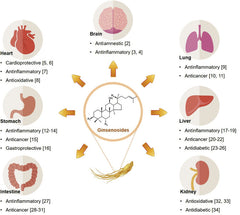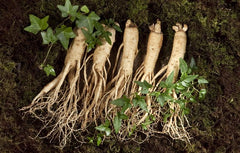(This was translated Resources from K-FDA (Ministry of Food and Drug Safety))
Red Ginseng
Potential Benefits:
- Enhances immune function
- Improves fatigue
- Promotes blood flow by inhibiting platelet aggregation
- Enhances memory
- Provides antioxidant effects
- Supports health in menopausal women
Raw Material Characteristics:
The raw material of red ginseng, Panax ginseng C.A. Meyer, has traditionally been used in Korea, China, Japan, and other countries for health promotion. Depending on the primary processing method that retains the original shape of the ginseng, it can be classified into fresh ginseng, red ginseng, and white ginseng.
-
Ginseng is included in the current "Food Standards and Specifications" [Appendix 1] "Raw materials that can be used in food" list and is referred to as fresh ginseng, white ginseng, red ginseng, black ginseng, wild ginseng, cultured ginseng, and Korean ginseng. The parts used are the root, stem (only for hydroponic ginseng), leaves, fruit, and seeds. The ginseng root used as raw material must comply with the "Ginseng Industry Act," be at least 4 years old, and not include seedling ginseng, wild ginseng, or damaged ginseng without removing the diseased parts.
-
Red ginseng refers to fresh ginseng (Panax ginseng C.A. Meyer) that has been steamed or otherwise processed and dried. During the manufacturing process, the browning reaction is promoted, giving it a dark brown color. When fresh ginseng is cooked and dried, compounds such as ginsenosides Rg2, Rg3, Rh1, and Rh2 are produced, which are known to improve learning ability, exhibit antithrombotic activity, and provide antioxidant effects.
-
Functional Components: The functional components (or marker compounds) of red ginseng are determined by the total content of ginsenosides Rg1, Rb1, and Rg3. Depending on the extraction method and manufacturing process, the ginsenoside content may vary, but according to manufacturing standards, the total content of ginsenosides Rg1, Rb1, and Rg3 should be at least 2.5 mg per gram of functional raw material.
Safety Evaluation:
- Red ginseng powder or its extract has been safely consumed for a long time. No toxicity was observed in single or repeated dose toxicity tests, and no adverse effects were reported in numerous human studies related to red ginseng consumption.

Functional Evaluations:
-
Immune Function Enhancement:
- Lee et al. (2012) reported that when leukemia children consumed red ginseng extract for a year, the levels of inflammatory cytokines (IL-2, IL-10, IL-12, TNF-a, INF-y) increased by chemotherapy were reduced .
- Suh et al. (2007) confirmed that red ginseng extract consumption by colon cancer patients for 3 months reduced chemotherapy-increased inflammatory cytokines (IL-8, IL-10) .
- According to a human trial review (2018), 99 adult participants with upper respiratory tract infections showed significant increases in lymphocyte surface antigens, indicating improved immune function .
-
Fatigue Improvement:
- Yoon et al. (2008) found that male college students majoring in physical education who consumed red ginseng and engaged in endurance exercise showed rapid recovery of blood lactate levels, suggesting positive effects on aerobic exercise performance and fatigue recovery .
- A 2017 study on 57 shift workers (23-44 years) reported that red ginseng consumption improved subjective fatigue, stress, and sleep quality .
- Another study on 18 healthy male college students (19-22 years) showed that consuming red ginseng concentrate significantly reduced creatine phosphokinase and blood lactate levels, confirming its effectiveness in preventing muscle injury and fatigue recovery from exercise .
-
Promotes Blood Flow by Inhibiting Platelet Aggregation:
- Shin et al. (2007) reported that consuming red ginseng for 8 weeks improved blood circulation by inhibiting platelet aggregation in healthy adults (20-65 years) with cholesterol levels of 180-250 mg/dl .
- Lee and Park (1998) and Lee and Kim (1995) reported that long-term red ginseng consumption improved blood circulation and helped prevent arteriosclerosis .
- Jovanovski et al. (2014) confirmed improved endothelial function and vascular health in healthy adults (18-65 years) who consumed red ginseng.

-
Memory Improvement:
- Yeo et al. (2012) found significant improvements in cognitive ability (event-related potential) in healthy adult men (19-25 years) who consumed red ginseng .
- Jeong et al. (2015) reported significant improvements in cognitive performance indicators (CVLT test) and prefrontal cortex response inhibition in adults (18-65 years) who consumed red ginseng powder for 8 weeks .
- Mariage et al. (2020) reported improvements in attention, memory, and stress in adults (18-65 years) who consumed red ginseng powder for 2 weeks .
-
Antioxidant Effects:
- Kim et al. (2012) found significant reductions in oxidized LDL levels and increases in blood antioxidant enzyme activity in healthy adults (20-65 years) who consumed red ginseng for 8 weeks .
- Lee et al. (1998) reported significant reductions in oxidative DNA damage and protein oxidation in healthy smokers (19-31 years) who consumed red ginseng for 4 weeks .
- Two studies by Lee Cheong-moo et al. (1999, 2000) confirmed increased antioxidant enzyme levels and inhibition of lipid peroxidation in healthy female college students who consumed red ginseng or red ginseng with vitamins .
- Kim Seong-su et al. (2006) found increased blood antioxidant enzyme levels and inhibited lipid peroxidation in male college students who consumed red ginseng along with exercise .
- Postmenopausal women (45-60 years) who consumed red ginseng showed increased antioxidant enzyme activity and reduced oxidative stress .
-
Supports Health in Menopausal Women:
- Kim et al. (2012) reported significant improvements in menopausal symptoms, such as the Kupperman index and hot flashes, in postmenopausal women (45-60 years) who consumed red ginseng for 12 weeks .
- Ogita et al. (1990) found reduced menopausal symptoms in women who consumed red ginseng powder .
- Tode et al. (1999, 2003) reported significant reductions in anxiety and menopausal symptoms in postmenopausal women who consumed red ginseng powder .
- Kikuchi et al. (2003) confirmed improvements in the Kupperman index and cardiovascular health indicators (blood PAI1) in postmenopausal women who consumed red ginseng powder .

Dosage and Precautions:
-
Dosage: The consumption levels of red ginseng raw materials confirmed in human trials range from 0.9 g to 9 g. The daily intake of functional ingredients ginsenosides Rg1, Rb1, and Rg3 varies depending on the raw material, manufacturing method, and extraction solvent. The current daily intake for "immune enhancement and fatigue improvement" is 3-80 mg, for "improvement of blood flow, memory, and antioxidant effects" is 2.4-80 mg, and for "health support in menopausal women" is 25-80 mg. To prevent excessive intake, the maximum daily intake for all functional components is uniformly set at 80 mg.
-
Precautions: Since ginsenosides in red ginseng can reduce platelet coagulation and enhance the hypoglycemic effect, caution is required when taking antidiabetic drugs and blood anticoagulants . Red ginseng may cause allergic reactions, so individuals with allergies should be cautious . Depending on the individual's constitution or characteristics, adverse effects may occur, and in such cases, consumption should be discontinued and a healthcare professional consulted.





